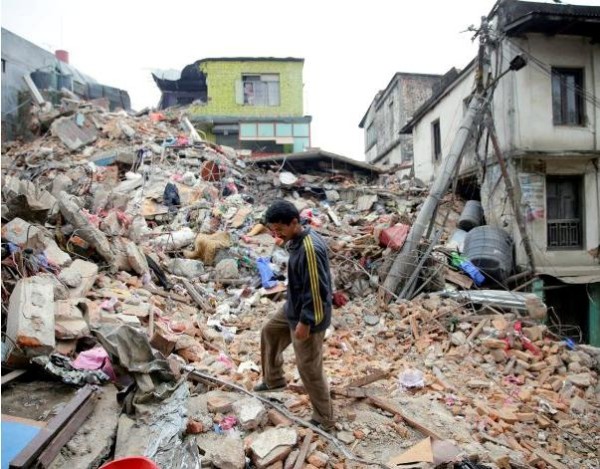In a single moment, the whole country of Nepal was changed forever. On Saturday April 25, a 7.8 magnitude earthquake struck the country – buildings collapsed and demolished, telephone poles shook, sand and debris buried homes, ancient monuments toppled, and the people frantically rushed out of their buildings into the streets. Chaos engulfed the nation. Most recent reports indicate that over 7,000 men, women, and children, died under the mounting debris. In addition, over 14,000 individuals were injured. [ref] “Nepal Earthquake Death Toll Climbs Past 7,000,” NBC News, May 3, 2015, accessed May 5, 2015. http://www.msnbc.com/msnbc/nepal-earthquake-death-toll-climbs-past-7000. [/ref] Seismologists and other scientists, consider this the worst earthquake Nepal has seen in nearly eighty-one years. [ref] Shrestha, Manesh, Ray Sanchez and Wayne Drash, “Earthquake Slams Nepal; Devasting Loss of People, History,” CNN News, April 27, 2015, accessed May 3,2015. http://www.cnn.com/2015/04/25/asia/nepal-earthquake-7-5-magnitude/[/ref]
But then came international aid. The level of global response for Nepal’s earthquake is quite admirable. The United States, in particular, pledged a generous donation of $10 million in financial assistance, along with 45 tons in supplies. India also rushed to the rescue, with approximately 1,000 personnel to help search and recover victims, as well as food, medicine, water, blankets, and aircrafts to aid the relief efforts. China rallied their efforts by sending rescue teams and giving $3.3 million in aid. Israel sent 95 tons of aid, dispatched a plane carrying a 200 medical and rescue personnel, and sent a team of 260 individuals to aid with relief. Other countries that came to assist include the United Kingdom, the European Union, Australia, Malaysia, and Pakistan. [ref] Helen Reagan, “International Aid to Nepal Ramps Up,” Time Magazine, April 28, 2015, accessed May 2, 2015. http://time.com/3837688/nepal-earthquake-aid-relief-donations/ [/ref]
But the vendetta is this: Are these donations, these supplies, these rescue teams, enough? And if it isn’t, what else should be done to stand with Nepal in their time of distress? The total loss and reconstruction costs could exceed $10 billion, according to the U.S. Geological Survey. [ref]“M7.8 – 34km ESE of Lamjung, Nepal,” USGS, accessed May 4, 2015, http://earthquake.usgs.gov/earthquakes/eventpage/us20002926#impact_pager.[/ref] Nepal, one of the poorest countries in Asia where the national GDP is $20 billion, will definitely encounter a number of difficulties meeting this cost. [ref] “Country at a Glance,” World Bank, accessed May 4, 2015, http://www.worldbank.org/en/country/nepal. [/ref] Indeed, this earthquake affected more than just the country’s infrastructure. No doubt, tourism – which comprises ten-percent of Nepal’s GDP – is expected to decrease, with less and less foreigners exploring Mt. Everest and other natural wonders in the region. Recovery may also be difficult due to corruption, as well as a lack of organization, in Nepal. The country had just come out of a ten year civil war in 2006, and still does not have a strong governing system in place.
However heated the international community might be towards the aftermath of the earthquake, eventually the news of Nepal will die down. The short-term aid acts as a quick fix, but what about the long term? How will Nepal recover and rebuild their country back from the ashes? Or will Nepal be labeled as another Haiti? Nepal and Haiti share striking similarities – Both countries are extremely poor, lack adequate infrastructure, and have instable governments. With Haiti, the U.S. donated $1.4 billion towards relief efforts when an earthquake ravaged the island in 2010. In fact, Haiti received a total of $13.5 billion from the international community. [ref] Richard Knox, “5 Years After Haiti’s Earthquake, Where Did The $13.5 Billion Go?” NPR, January 12, 2015, accessed May 4, 2015, http://www.npr.org/blogs/goatsandsoda/2015/01/12/376138864/5-years-after-haiti-s-earthquake-why-aren-t-things-better. [/ref] Yet the harsh reality of the Haitian earthquake is that even now, five years later, residents are still struggling to recover. A great many Haitians still live in tents and temporary housing. Furthermore, the benefits of the $13.5 billion in financial aid given to Haiti seem difficult to measure. The Disaster Accountability Project examined Haiti one year later and found that half of the money received from financial aid sat unspent in banks despite the continued need for homes to be rebuilt and people to recover. [ref] Gardiner Harris, “Nepal Asks Foreign Rescuers to Leave as Hopes Fade,” NY Daily, May 4, 2015, accessed May 5, 2015, http://www.nytimes.com/2015/05/05/world/asia/nepal-earthquake-foreign-rescuers.html?_r=0. [/ref]
To prevent Nepal from becoming another Haiti, there must be accountability to where the money is being spent and to whom the money is being given. Financial aid with clear oversight is imperative. Perhaps donating to smaller local grassroots organizations in Nepal may be the best short solution at this point and time. This can ensure that a greater percentage of donations will be used towards disaster relief and recovery, and that the money goes directly to the people, instead of corrupt politicians. Moreover, local grassroots organizations can help alleviate the current overcrowding of volunteers and supplies at Katmandu’s airport, with better administration and prudent spending. Indeed, Local grassroots organizations understand their country’s needs, and they are the ones who should be empowered in order to see their country rise up from the rubble.
Take Action:
To be a part of the recovery process, visit the Shikshya Foundation, an organization committed to bringing both short-term and long-term relief. Sama Hope is another non-profit organization that is not only dedicated to training medical personnel, but will also help rebuild the medical buildings that have been destroyed.





